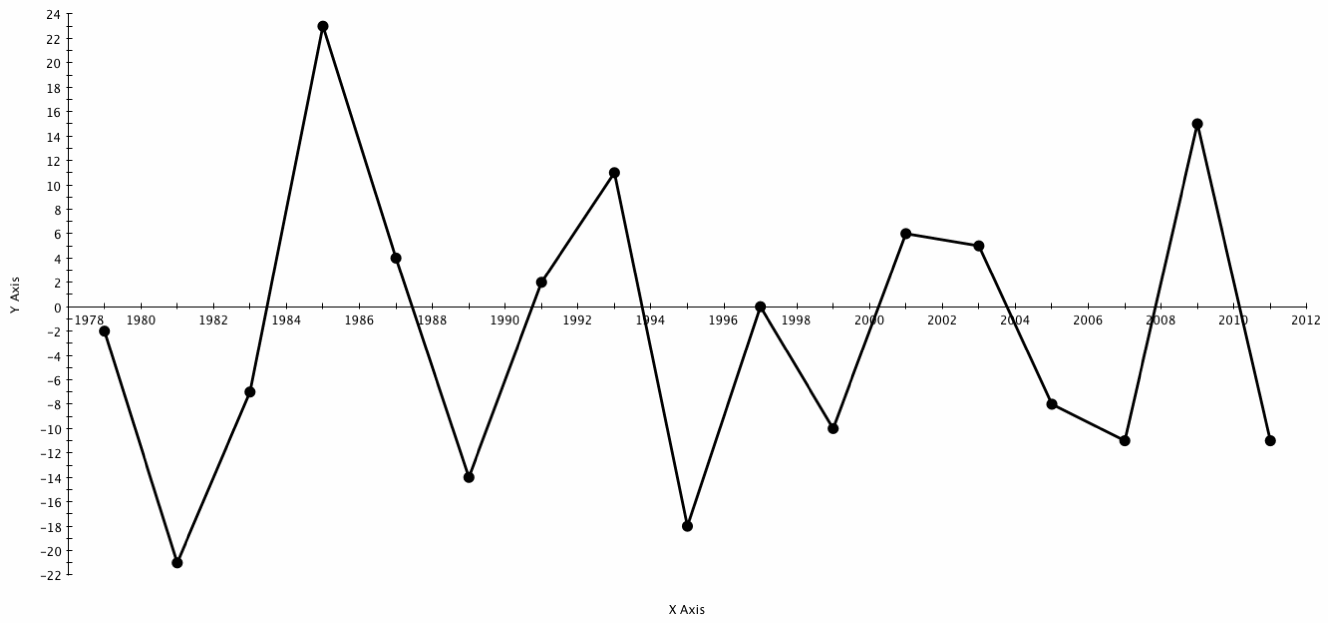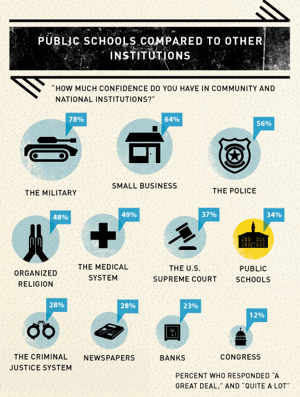The other day I featured an infographic on IGad (InfoGrapthic-a-Day) that illustrated the declining or less than satisfactory level of confidence that the American public has in it’s education system. This was probably not an appropriate graphic to share on what was, for many, their first day back to school. But hey, what do we have to be exuberant about in the world of education today, besides the intrinsic joys and rewards of teaching — and having a job teaching. So I posted this GOOD.is graphic because I think it’s conversation needs starting.
At the top of the graphic is a not quite so striking decline in confidence since 1977 — 54% then to 38%  today. Of course, we understand that this is merely a symptom of things going on that are much deeper and broader than what’s happening in real classrooms. What I found most interesting with this part of the graphic was that the decline was not steady. I dumped the data into one of my favorite graphing tools, OmniGraphSketcher, and produced the line graph at the right. It would be interesting to correlate the rather dramatic ups and downs of confidence levels with what was going on outside of our classrooms — the stories that were being told by people who had influence to gain by telling those stories.
today. Of course, we understand that this is merely a symptom of things going on that are much deeper and broader than what’s happening in real classrooms. What I found most interesting with this part of the graphic was that the decline was not steady. I dumped the data into one of my favorite graphing tools, OmniGraphSketcher, and produced the line graph at the right. It would be interesting to correlate the rather dramatic ups and downs of confidence levels with what was going on outside of our classrooms — the stories that were being told by people who had influence to gain by telling those stories.
What I found most interesting about the entire graphic was the portion that compared confidence values for other institutions, ranging from the military, with a confidence rate of 78%, down to, well, need I say, congress, with only 12% expressing confidence. ..and where did they find them?
 Looking at the ranking on the right, I see an interesting, though blurry difference between the institutions earning more than 40% confidence, and the ones getting less. The military protects us and we feel it. The threat of terrorism is on our minds. We walk into small businesses everyday and we encounter the police, our churches and doctors every week — or there is a potential of encountering them.
Looking at the ranking on the right, I see an interesting, though blurry difference between the institutions earning more than 40% confidence, and the ones getting less. The military protects us and we feel it. The threat of terrorism is on our minds. We walk into small businesses everyday and we encounter the police, our churches and doctors every week — or there is a potential of encountering them.
On the other hand, most of us have very little direct weekly experience with the inner workings of our courts, schools, criminal justice system, newspapers, banks and congress. It is worth noting that Americans experience a significantly greater likelihood of being in jail, prison, or on probation or parole than we do of graduating from high school this year. ((“Total Correctional Population.” Bureau of Justice Statistics. U.S. Department of Justice, 7 Sep 2011. Web. 7 Sep 2011.)) ((“Fast Facts.” National Center for Education Statistics. U.S. Education Department, n.d. Web. 7 Sep 2011.))
Admittedly, there is a lot of gray space in this distinction. But my point is this. People will be less confident in something that they do not see regularly, or they can be more easily be dissuaded of their confidence by political spin. We’ve got to do a better job of inviting the public into our schools. We’ve got to sell them on “21st Century Learning” by showing it to them. We’ve got to inspire confidence by making people wish they could go back to high school. We need to ask ourselves the question, “How do we inspire confidence?
Data? ..or Performance?”

Mr. Warlick,
I completely agree with your blog post and all the points of interest you made. I do feel myself that the confidence level of the public towards our schools has dropped dramatically over the years. The people have let other non priority issues come before the educational learning of the kids today. Instead of going to PTO meetings, or open houses they have put their priorities in other areas. The public should want to put a huge amount of confidence in back in the future of their child’s education.The amount of teenage dropout rates, pregnancy rate, drug and alcohol abuse rate, has become so common these days. The importance of education to the public and teens has been put on the back burner. Education should consist of more confidence than shown in the graphs. I was absolutely astonished at the percentage of confidence in the general public has an education. In my opinion education today is an essential part of life most importantly in a career. You asked the question “what do we do to inspire more confidence?” I believe we should inspire with performance and knowledge. Being able to show performance we should use the new learning tools and ideas that are developing every day. Confidence will soon rise back in the public towards our schools but we have to give them something to be confident in! Schools could extend invitations to the public for school events, performances, meetings and daily bulletins. I have really enjoyed your posts and will keep following them! You can follow me on twitter @morganclark28 or visit my blog at http://www.clarkmorganedm310.blogspot.com.
I find that both Mr. Warlick and Mr. Clark’s posts have some truth to them, but there’s another issue I’d like to bring up. I’ve often overheard people complaining that they don’t trust the educational system due to its lack of funding. However, these same people often rally to cut funding from public schools because they don’t trust the system to properly educate their children. Basically, there appears to be a case of circular reasoning in the public’s mind when it comes to education, and that should be addressed and resolved ASAP so that the other changes you propose can stand a chance of getting off the ground.
Mr. Warlick
I find your graph very interesting as it depicts the waxing and waning of public confidence. I am not sure I understand the correlation between this and other factors mentioned. Did you find any reason(s) for the up and down confidence of people toward public education. Also, how was confidence measured? What population of people took the survey that produced these results?
Gail
I believe with your post as well. It is my observation that when something goes wrong in the economy, government system, community, or legistlature, that we need to blame these mistakes or problems on something. I find that the school system gets blamed a lot. Lack of funding has decreased the resources at the school, the caliber of teachers, the technology used in the classroom, the administration, the involvement of PTO meetings, ect. Society finds that the school system is an easy target because it cannot fight back as easily. It is a government run and funded program, and will not be able to bounce back to the harsh critism it receives on a daily basis. When the economy begins to rise and “recover” I will not be suprised to find the graph increase as well.
I think attitude plays a huge role in this conversation. When is the last time you watched the news and saw something positive? Chances are it was about a crime, or in this past weeks execution of Troy Davis, a protest. The truth is Americans are addicted to drama. The media realizes this and so that is exactly what is on the evening news. I personally have never seen on the news of when a school has excelled or improved. I have only seen stories of failing districts, wrongs doings of principals and staff, and budget cuts. In reality there is much good to report in our schools however, it is sad that these stories are never focussed on.
Sadly, I believe the reverse is true as well. We do trust what we can see, even if the visible portion is but a tiny part of the picture. Because of apparent tunnel vision, the public (and, unfortunately, some school boards seem to trust only the test scores they can see and not the real life success stories students and families attempt to bring to light.